fuel Peugeot Boxer 2008.5 Owner's Manual
[x] Cancel search | Manufacturer: PEUGEOT, Model Year: 2008.5, Model line: Boxer, Model: Peugeot Boxer 2008.5Pages: 167, PDF Size: 4.17 MB
Page 4 of 167
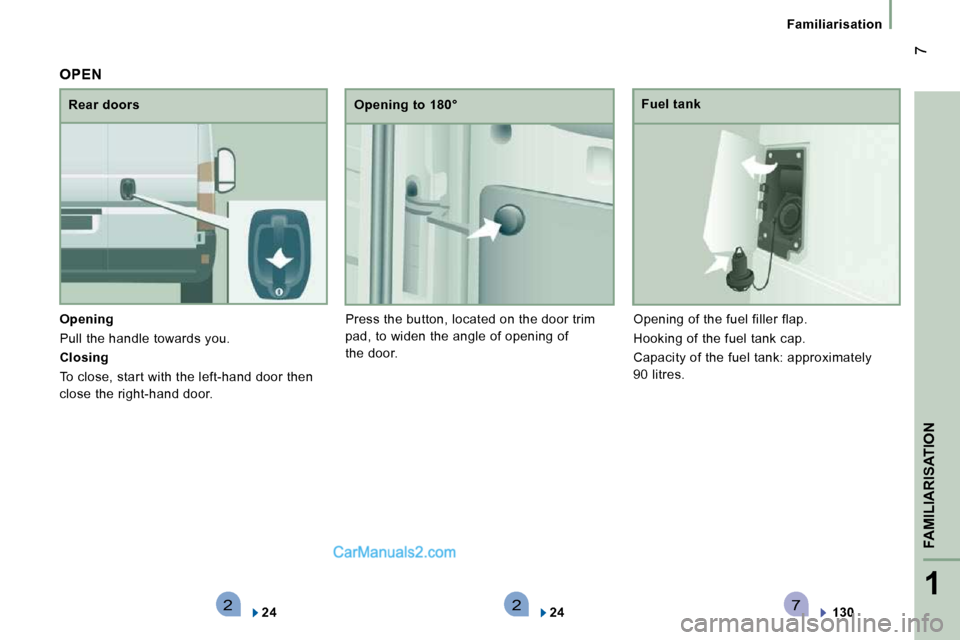
2271
FAMILIARISATION
7
Familiarisation
Opening
Pull the handle towards you.
Closing
To close, start with the left-hand door then
close the right-hand door. Rear doors
Opening to 180°
Press the button, located on the door trim
pad, to widen the angle of opening of
the door. Fuel tank
Opening of the fuel filler flap.
Hooking of the fuel tank cap.
Capacity of the fuel tank: approximately
90 litres.
24
OPEN
24
130
Page 28 of 167
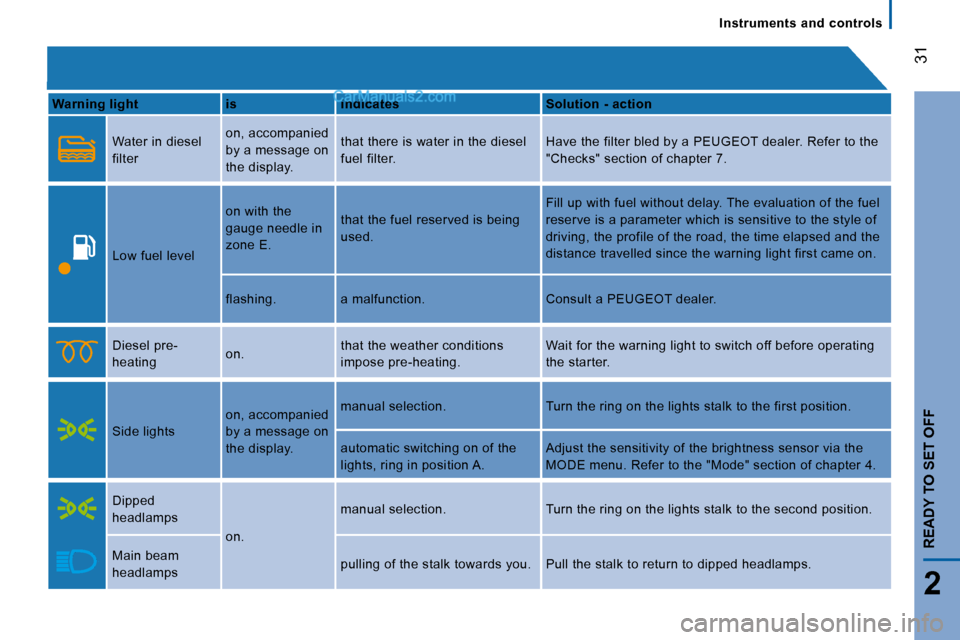
Instruments and controls
31
2
READY TO SET OFF
Warning light is indicates Solution - action
Water in diesel
filter on, accompanied
by a message on
the display. that there is water in the diesel
fuel filter.
Have the filter bled by a PEUGEOT dealer. Refer to
the
"Checks" section of chapter 7.
Low fuel level on with the
gauge needle in
zone E.
that the fuel reserved is being
used. Fill up with fuel without delay. The evaluation of
the fuel
reserve is a parameter which is sensitive to the st yle of
driving, the profile of the road, the time elapsed and the
distance travelled since the warning light first ca me on.
flashing. a malfunction. Consult a PEUGEOT deale r.
Diesel pre-
heating on. that the weather conditions
impose pre-heating. Wait for the warning light to switch off before op
erating
the starter.
Side lights on, accompanied
by a message on
the display. manual selection. Turn the ring on the lights sta
lk to the first position.
automatic switching on of the
lights, ring in position A. Adjust the sensitivity of the brightness sensor vi
a the
MODE menu. Refer to the "Mode" section of chapter 4 .
Dipped
headlamps on. manual selection. Turn the ring on the lights sta
lk to the second position.
Main beam
headlamps pulling of the stalk towards you. Pull the stalk
to return to dipped headlamps.
Page 31 of 167

Instruments and controls
34
FUEL GAUGE
The fuel level is tested each time the key is
turned to the "running" position.
The gauge is positioned on:
- F (Full): the fuel tank is full,
approximately 90 litres.
- E (Empty): the reserve is now being
used, the warning light comes on
continuously.
The reserve when the warning first comes
on is approximately 11 litres.
Fuel tanks of different capacities (60 and
125 litres) are available as an option.
COOLANT TEMPERATURE
The needle is positioned between C
(Cold) and H (Hot): normal operation.
In arduous conditions of use or hot climatic
conditions, the needle may move close to
the red graduations. - wait for the engine to cool down in
order to check the level and top it up if
necessary. Follow this advice:
the cooling system is pressurised. In order to avoid any risk of scalding,
unscrew the cap by two turns to allow
the pressure to drop.
When the pressure has dropped, check the
level and remove the cap to top up.
If the needle remains in the red zone,
contact a PEUGEOT dealer.
Refer to the "Levels" section of
chapter 7.
Refer to the "Fuel" section of chapter 7.
What you should do if the needle enters the
red zone, or if the warning light comes on:
- stop immediately, switch off the ignition. The fan may continue to operate for a
certain time up to approximately
10 minutes.
EMISSION CONTROL
EOBD (European On Board Diagnosis) is
a diagnostics system which complies with,
among others, the standards concerning
authorised emissions of:
- CO (carbon monoxide),
- HC (unburnt hydrocarbons),
- NOx (nitrogen oxides) or particles, detected by oxygen sensors placed
upstream and downstream of the
catalytic converters.
Therefore, the driver is warned of any
malfunction of this emission control
�s�y�s�t�e�m� �b�y� �t�h�e� �l�i�g�h�t�i�n�g� �o�f� �t�h�i�s� �s�p�e�c�i�fi� �c�
warning light on the instrument panel.
There is a risk of damage to the catalytic convert er.
Have it checked by a PEUGEOT dealer.
Page 34 of 167
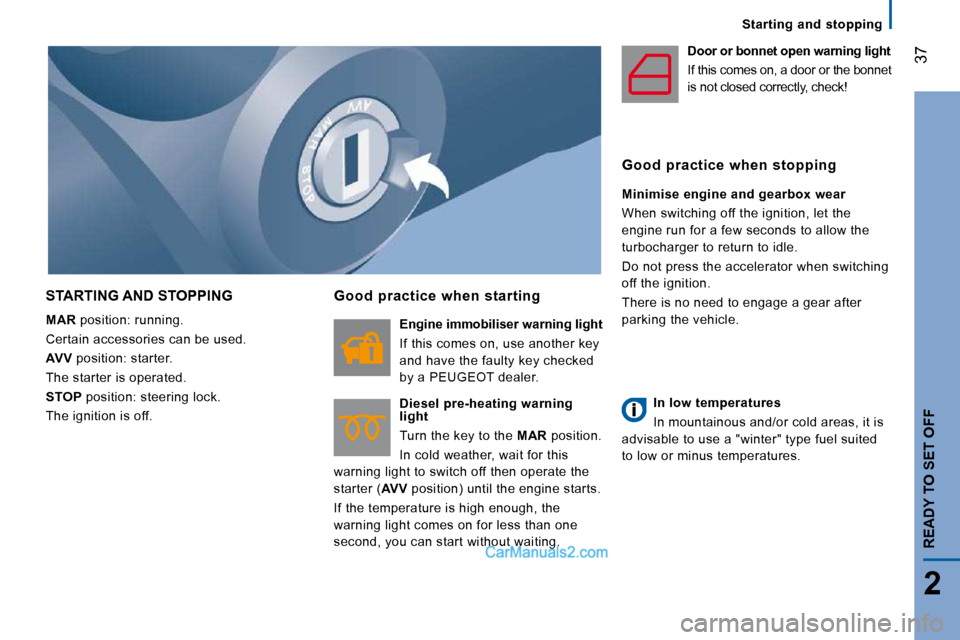
37
2
READY TO SET OFF
Starting and stopping
STARTING AND STOPPING
MAR position: running.
Certain accessories can be used.
AVV position: starter.
The starter is operated.
STOP position: steering lock.
The ignition is off.
Good practice when starting
Engine immobiliser warning light
If this comes on, use another key
and have the faulty key checked
by a PEUGEOT dealer.
Diesel pre-heating warning
light
Turn the key to the MAR position.
In cold weather, wait for this
warning light to switch off then operate the
starter ( AVV position) until the engine starts.
If the temperature is high enough, the
warning light comes on for less than one
second, you can start without waiting. Door or bonnet open warning light
If this comes on, a door or the bonnet
is not closed correctly, check!
Good practice when stopping
Minimise engine and gearbox wear
When switching off the ignition, let the
engine run for a few seconds to allow the
turbocharger to return to idle.
Do not press the accelerator when switching
off the ignition.
There is no need to engage a gear after
parking the vehicle.
In low temperatures
In mountainous and/or cold areas, it is
advisable to use a "winter" type fuel suited
to low or minus temperatures.
Page 55 of 167
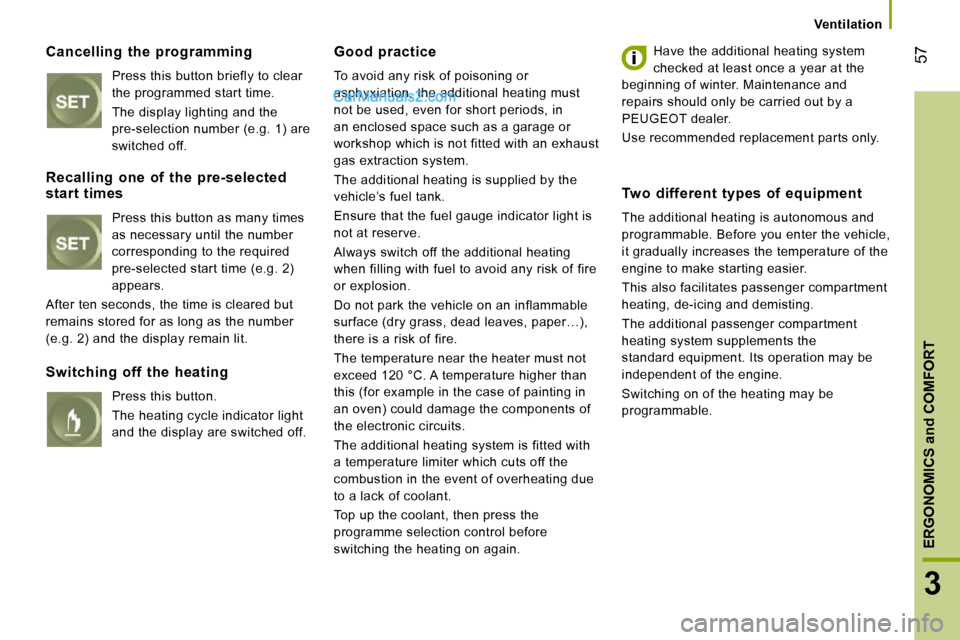
57
3
ERGONOMICS and COMFORT
Ventilation
Cancelling the programming
Press this button briefly to clear
the programmed start time.
The display lighting and the
pre-selection number (e.g. 1) are
switched off.
Good practice
To avoid any risk of poisoning or
asphyxiation, the additional heating must
not be used, even for short periods, in
an enclosed space such as a garage or
workshop which is not fitted with an exhaust
gas extraction system.
The additional heating is supplied by the
vehicle’s fuel tank.
Ensure that the fuel gauge indicator light is
not at reserve.
Always switch off the additional heating
when filling with fuel to avoid any risk of fire
or explosion.
Do not park the vehicle on an inflammable
surface (dry grass, dead leaves, paper…),
there is a risk of fire.
The temperature near the heater must not
exceed 120 °C. A temperature higher than
this (for example in the case of painting in
an oven) could damage the components of
the electronic circuits.
The additional heating system is fitted with
a temperature limiter which cuts off the
combustion in the event of overheating due
to a lack of coolant.
Top up the coolant, then press the
programme selection control before
switching the heating on again. Have the additional heating system
checked at least once a year at the
beginning of winter. Maintenance and
repairs should only be carried out by a
PEUGEOT dealer.
Use recommended replacement parts only.
Recalling one of the pre-selected start times
Press this button as many times
as necessary until the number
corresponding to the required
pre-selected start time (e.g. 2)
appears.
After ten seconds, the time is cleared but
remains stored for as long as the number
(e.g. 2) and the display remain lit.
Switching off the heating
Press this button.
The heating cycle indicator light
and the display are switched off.
Two different types of equipment
The additional heating is autonomous and
programmable. Before you enter the vehicle,
it gradually increases the temperature of the
engine to make starting easier.
This also facilitates passenger compartment
heating, de-icing and demisting.
The additional passenger compartment
heating system supplements the
standard equipment. Its operation may be
independent of the engine.
Switching on of the heating may be
programmable.
Page 70 of 167
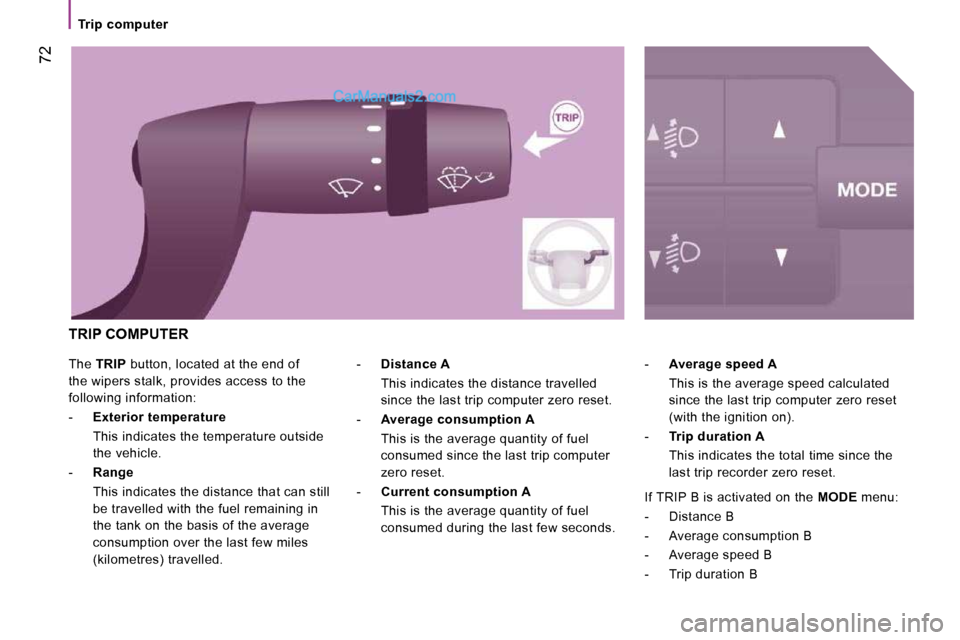
72
Trip computer
The TRIP button, located at the end of
the wipers stalk, provides access to the
following information:
- Exterior temperature
This indicates the temperature outside the vehicle.
- Range
This indicates the distance that can still be travelled with the fuel remaining in
the tank on the basis of the average
consumption over the last few miles
(kilometres) travelled. -
Average speed A
This is the average speed calculated since the last trip computer zero reset
(with the ignition on).
- Trip duration A
This indicates the total time since the last trip recorder zero reset.
-
Distance A
This indicates the distance travelled since the last trip computer zero reset.
- Average consumption A
This is the average quantity of fuel consumed since the last trip computer
zero reset.
- Current consumption A
This is the average quantity of fuel consumed during the last few seconds.
TRIP COMPUTER
If TRIP B is activated on the MODE menu:
- Distance B
- Average consumption B
- Average speed B
- Trip duration B
Page 131 of 167

130
Fuel
Low fuel level
When the fuel tank level E
(Empty) is reached, this warning
light comes on. At this moment,
you have enough fuel left to
drive approximately 30 miles (50 km) ,
depending on the driving conditions, the
engine and the profile of the road. Fill up
without delay to avoid running out of fuel. The fuel tank must be filled
with the engine
off.
- Open the fuel filler flap.
- Support the cap with one hand.
- With the other hand, insert the key, then turn it anticlockwise.
- Remove the cap and hook it onto the clip located on the inside of the flap.
A label affixed to the inside of the flap
reminds you of the type of fuel to be used.
When filling the fuel tank, do not continue
after the 3rd cut-off of the nozzle. This could
cause malfunctions.
The capacity of the fuel tank is
approximately 90 litres.
- After filling the fuel tank, lock the cap and close the flap.
FUEL CIRCUIT DEACTIVATED
In the event of a serious collision, a device
automatically cuts off the fuel supply
to the engine and the vehicle’s electrical
supply.
FILLING WITH FUEL
Fuel tanks of different capacities,
60 and 125 litres, are sold. Check that there is no smell or leak of fuel
outside the vehicle.
Restore the supply by pressing:
- the first button,
located below the steering wheel.
- the second button, located in the battery compartment, under the front
passenger ’s floor.
In low temperatures
In mountainous and/or cold areas, it is
advisable to use a "winter" type fuel suited
to low or minus temperatures.
Page 146 of 167
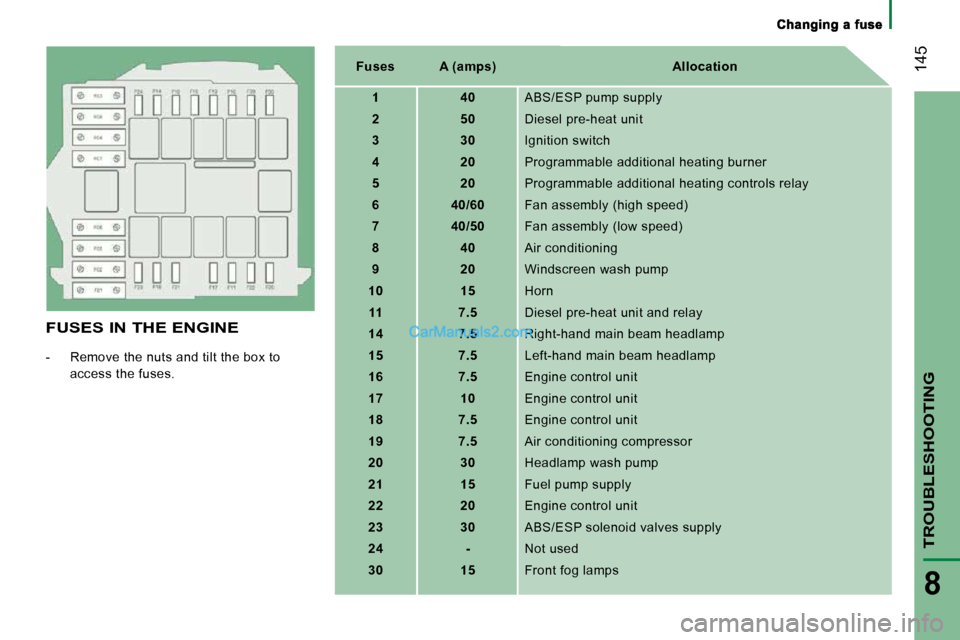
145
TROUBLESHOOTING
8
FUSES IN THE ENGINE
- Remove the nuts and tilt the box to access the fuses.
Fuses A (amps) Allocation
1 40 ABS/ESP pump supply
2 50 Diesel pre-heat unit
3 30 Ignition switch
4 20 Programmable additional heating burner
5 20 Programmable additional heating controls relay
6 40/60 Fan assembly (high speed)
7 40/50 Fan assembly (low speed)
8 40 Air conditioning
9 20 Windscreen wash pump
10 15 Horn
11 7 . 5 Diesel pre-heat unit and relay
14 7 . 5 Right-hand main beam headlamp
15 7 . 5 Left-hand main beam headlamp
16 7 . 5 Engine control unit
17 10 Engine control unit
18 7 . 5 Engine control unit
19 7 . 5 Air conditioning compressor
20 30 Headlamp wash pump
21 15 Fuel pump supply
22 20 Engine control unit
23 30 ABS/ESP solenoid valves supply
24 - Not used
30 15 Front fog lamps
Page 157 of 167
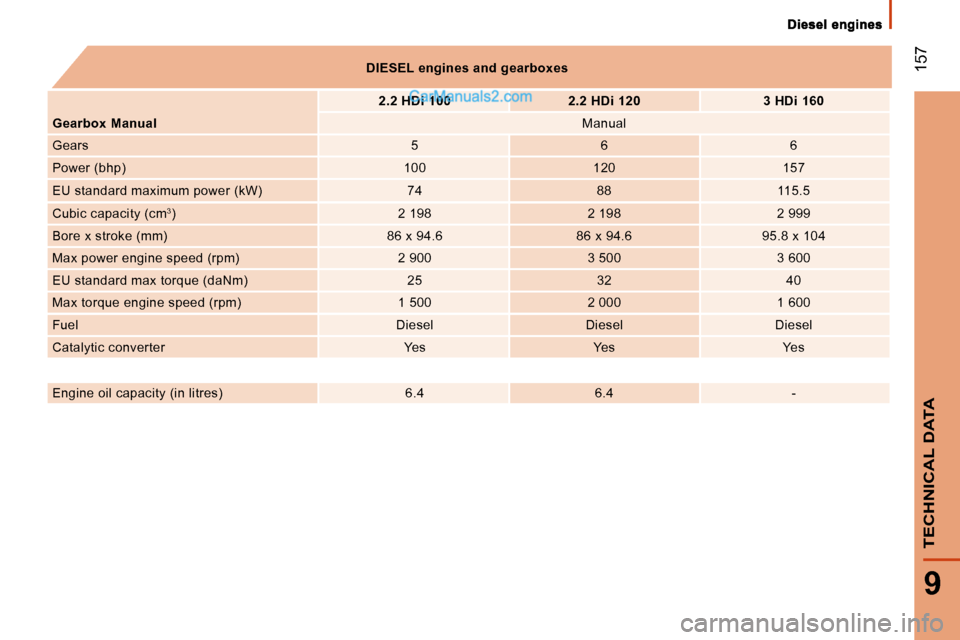
157
9
TECHNICAL DATA
DIESEL engines and gearboxes
2.2 HDi 100 2.2 HDi 120 3 HDi 160
Gearbox Manual Manual
Gears 5 6 6
Power (bhp) 100 120 157
EU standard maximum power (kW) 74 88 115.5
Cubic capacity (cm 3
) 2 198 2 198 2 999
Bore x stroke (mm) 86 x 94.6 86 x 94.6 95.8 x 104
Max power engine speed (rpm) 2 900 3 500 3 600
EU standard max torque (daNm) 25 32 40
Max torque engine speed (rpm) 1 500 2 000 1 600
Fuel Diesel Diesel Diesel
Catalytic converter Yes Yes Yes
Engine oil capacity (in litres) 6.4 6.4 -
Diesel engines Diesel engines
Page 162 of 167
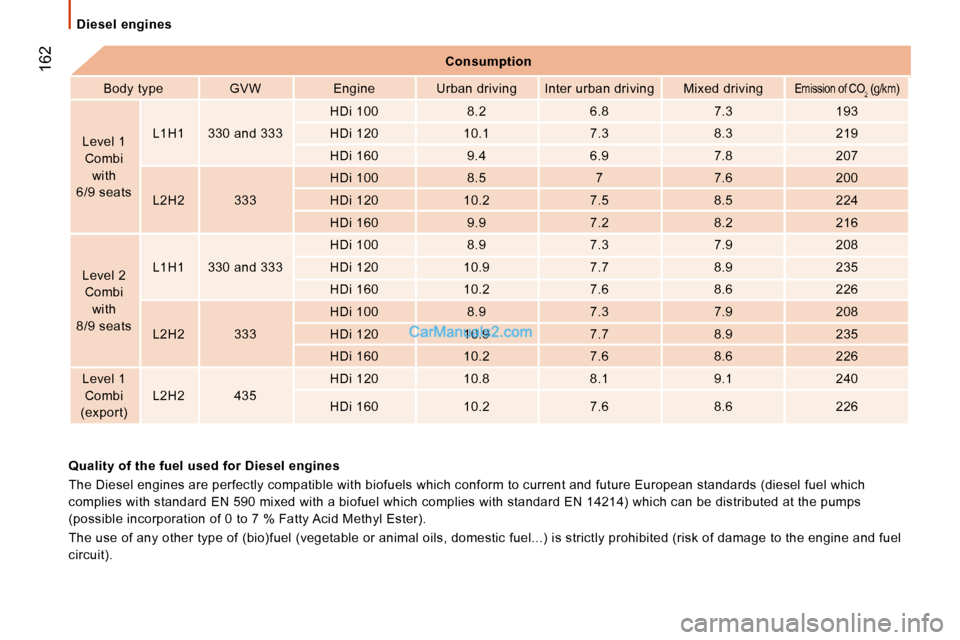
162
Diesel engines
Consumption
Body type GVW Engine Urban driving Inter urb an driving Mixed driving
Emission of CO
2 (g/km)
Level 1
Combi with
6/9 seats L1H1 330 and 333
HDi 100 8.2 6.8 7.3 193
HDi 120 10.1 7.3 8.3 219
HDi 160 9.4 6.9 7.8 207
L2H2 333 HDi 100 8.5 7 7.6 200
HDi 120 10.2 7.5 8.5 224
HDi 160 9.9 7.2 8.2 216
Level 2 Combi with
8/9 seats L1H1 330 and 333
HDi 100 8.9 7.3 7.9 208
HDi 120 10.9 7.7 8.9 235
HDi 160 10.2 7.6 8.6 226
L2H2 333 HDi 100 8.9 7.3 7.9 208
HDi 120 10.9 7.7 8.9 235
HDi 160 10.2 7.6 8.6 226
Level 1 Combi
(export) L2H2 435 HDi 120 10.8 8.1 9.1 240
HDi 160 10.2 7.6 8.6 226
Quality of the fuel used for Diesel engi nes
The Diesel engines are perfectly compatible with b iofuels which conform to current and future Europea n standards (diesel fuel which
complies with standard EN 590 mixed with a biofuel which complies with standard EN 14214) which can be distributed at the pumps
(possible incorporation of 0 to 7 % Fatty Acid Meth yl Ester).
The use of any other type of (bio)fuel (vegetable or animal oils, domestic fuel...) is strictly prohibited (risk of damage to the engine and fuel
circuit).